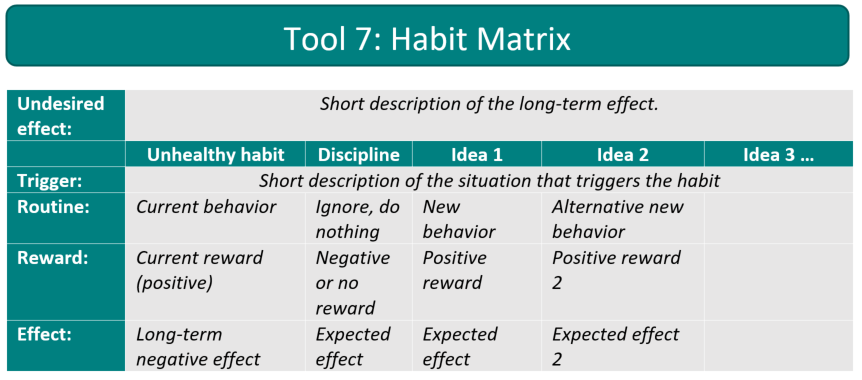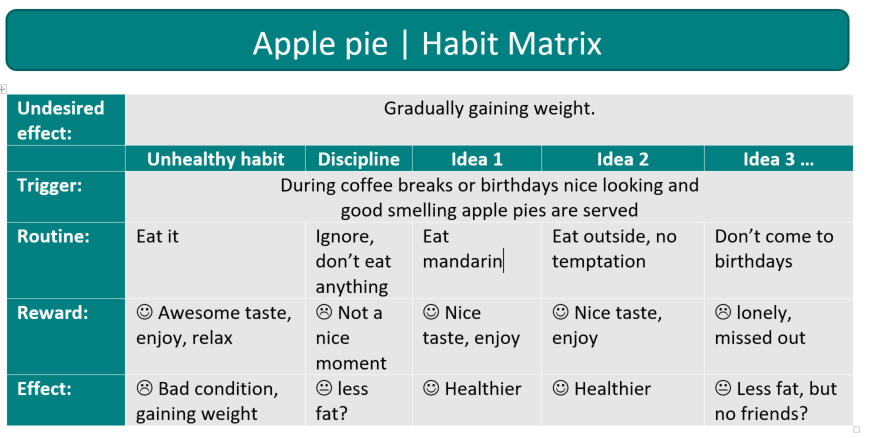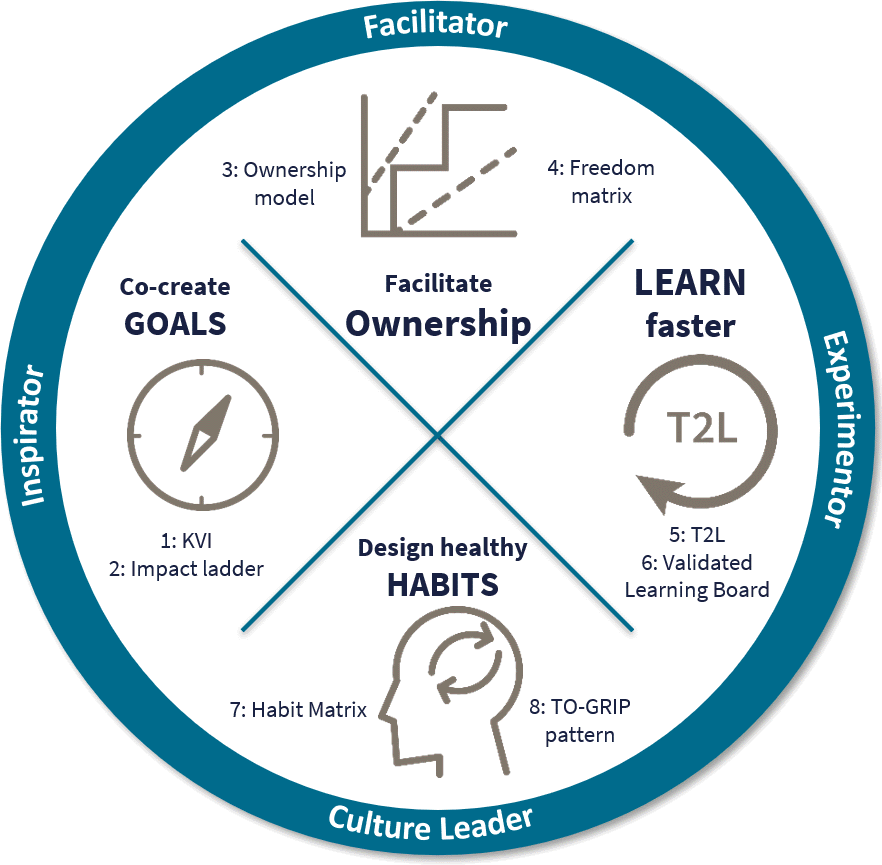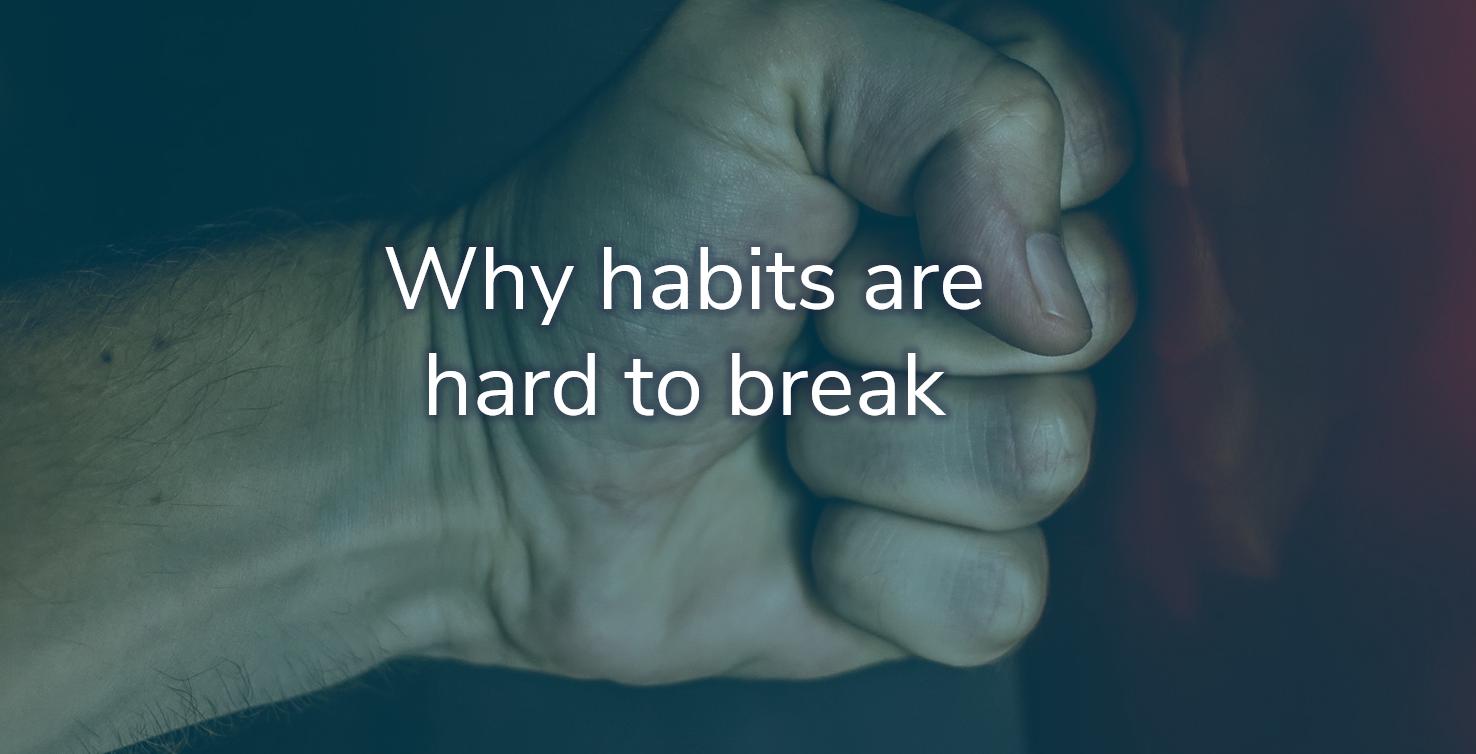
Habit matrix
Let's improve the culture
Unfortunately, it is often impossible to see the behavior of an individual employee whether this contributes to the agile culture in the long term. That makes it difficult to recognize unhealthy habits. It works better to study the undesirable long-term effect and to look for the underlying unhealthy habits. I have developed a tool to help agile leaders: the Habit Matrix. This tool supports brainstorming about undesirable effects and underlying unhealthy habits and helps to design healthy habits.
Find the toxic benefit
Nobody likes to do something with only negative rewards of benefits. You don't bump your head to the wall on a frequent basis, because it hurts and has (probably?) no benefit.
So why is there sometimes a negative culture in an organization? Why is there a bad culture that doesn't focus on the customer, that doesn't promote teamwork and doesn't reward quality?
That's because there are short-term benefits who are stronger, but these benefits kill the long-term benefits. These short-term benefits are toxic for the culture. Examples of toxic benefits:
- Delivering low quality - why would you do that? It seems irrational to deliver low quality. But often there are toxic benefits that support low quality. For example: the manager or stakeholder is satisfied with the quick delivery, the developer is the hero because he delivered it super fast, the sales person promised the customer it would be finished quickly and the organization kept it's promises, etc.
- Not learning from actual usage statistics - why would you not study the statistics of the customers behavior? Because delivering more output or velocity in the current sprint is rewarded by the managers and/or stakeholders. Because the stakeholders are already dissatisfied by all the stuff they have to wait for. Because it takes time to build logging and tracing and that time can also be spent in developing new features.
- Skipping the retrospective - why would you not invest in becoming a high performing team? Because it was already a very busy sprint and the next sprint is already fully booked. The frustrations are building up and ignoring them seems better than facing them, etc.
So the power of the habit matrix is to discover the (bad) short-term benefits that prevent the organization from harvesting the good and healthy long-term benefits.
Because a healthy culture is a culture where the people know they can't take shortcuts and have to focus on the long term quality, customer-value and continuous improvement.
The Habit-Matrix

Why this Habit matrix?
Habits are a powerful and strong part of the culture. In order to implement a culture change, the habits first have to change. Habits are quickly adopted by others. A good example of this adoption speed is the following video from Brain Games:
This experiment is also copied by a Dutch program:
A habit is an act or behavior that one is accustomed to and one does not think about explicitly. Think of brushing your teeth before going to bed, braking for red, pulling shoulders when you are tensed or taking off your shoes when you come home. A habit consists of three steps: trigger, routine and reward. The habit is triggered after which the routine
is rewarded. Together these three parts form the habit loop.
The trigger is a situation, moment or event. The routine is the action or action that might have been uncomfortable at first, but is becoming more and more routine. Because of the reward our brains make an increasingly strong connection between the trigger and the action, so we act without thinking about it.
Example Habit matrix

Recent blogs on culture
The toolkit
The steering wheel of the agile leader consists of four components. Each component consists of two practical tools. So in total eight tools. The tools are explained in such a way that leaders can immediately start working on this. The tools can be used separately and as such successful. Of course, all tools together – the toolkit – reinforce each other. It concerns the following eight tools:- KVI – the Key Value Indicator (KVI) is the most important indicator for value creation for the team.
- Impact ladder – for brainstorming and visualizing the customer impact. This helps teams continuously improve their products and services.
- Ownership model – visualizes what teams need to take ownership.
- Freedom matrix – what freedoms and responsibilities does the team have at what time.
- T2L – to measure the business agility.
- Validated Learning Board (VLB) – to visually keep track of the learning process of the team.
- Habit matrix – to support culture change and the design of new habits.
- TO-GRIP – to support the agile leader in implementing major improvements.



